Abstract
The ultrastructural features of cerebral contusion seen three hours to 11 days after head injury were studied in 18 patients undergoing surgery. Massive astrocytic swelling ("cytotoxic" oedema) was seen three hours to three days after injury, maximal in perivascular foot processes, and compressing some of the underlying capillaries. The tight junctions were not disrupted. Neuronal damage was most marked three to 11 days after injury. The pathophysiological mechanisms leading to oedema formation and neuronal degeneration are discussed.
Full text
PDF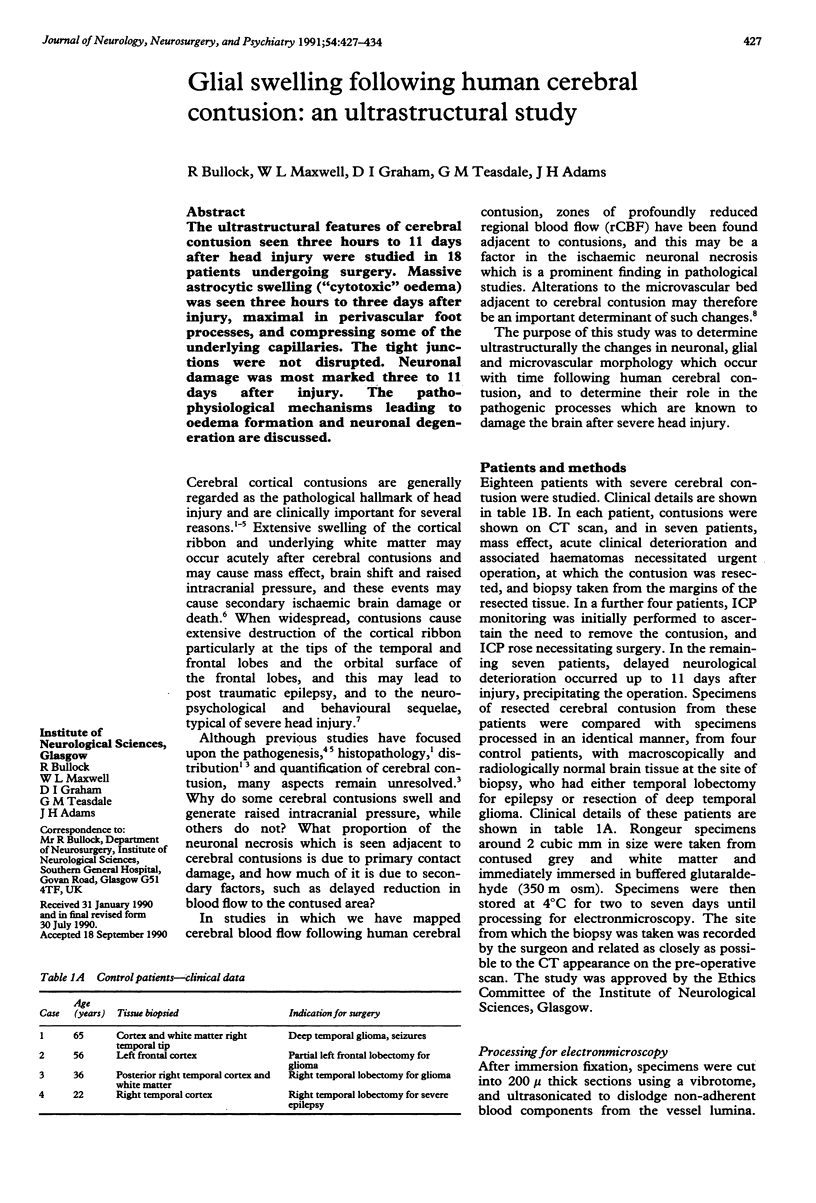


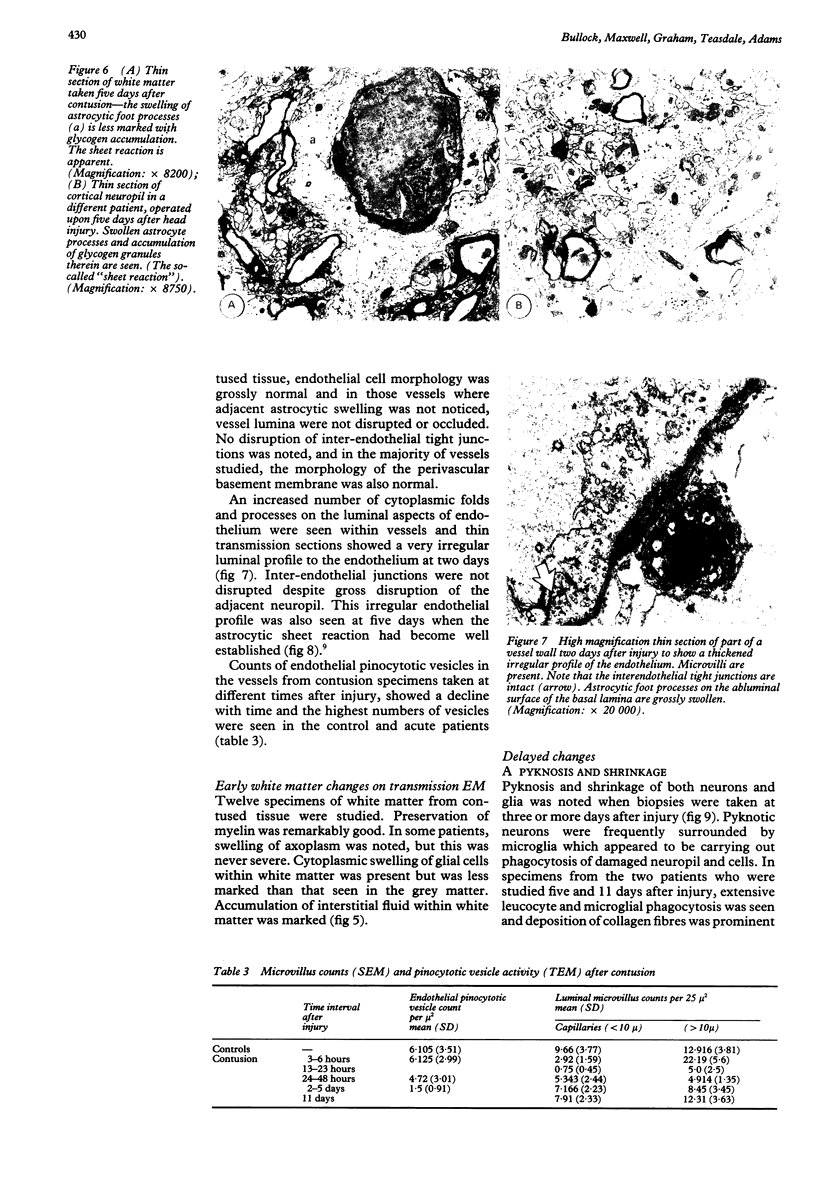
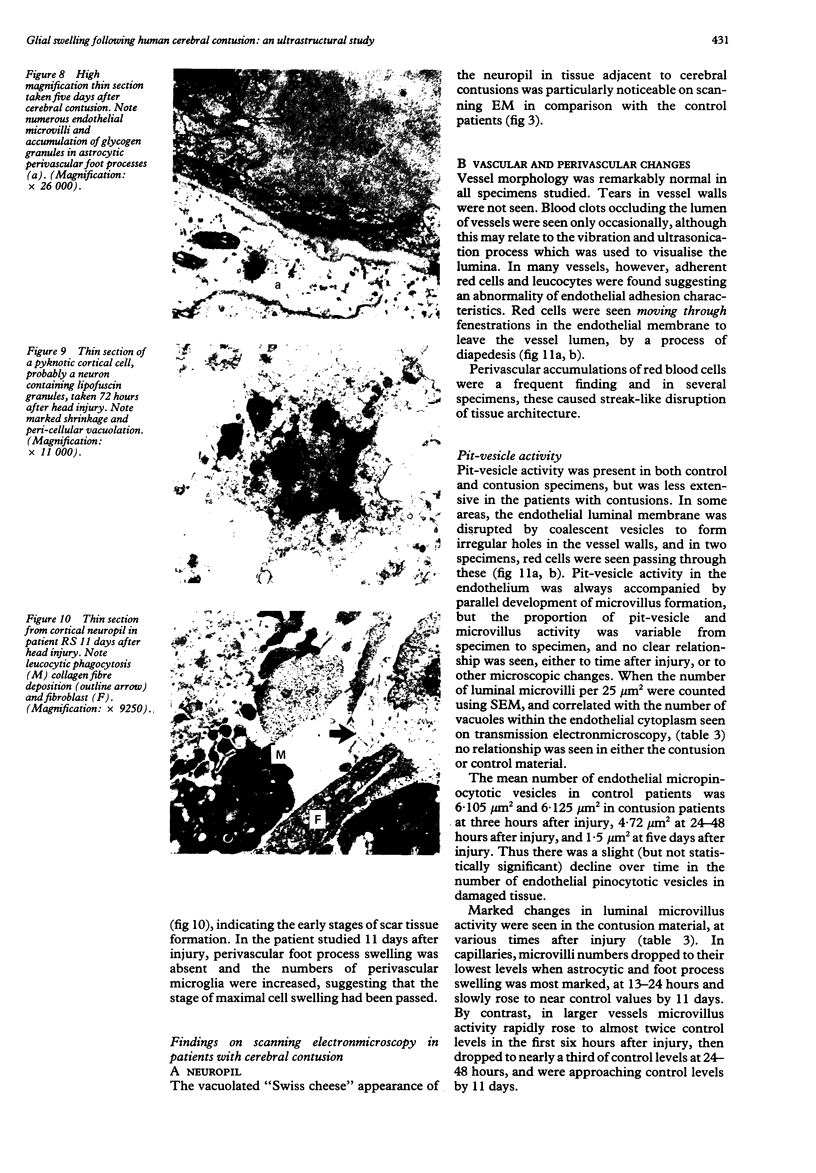
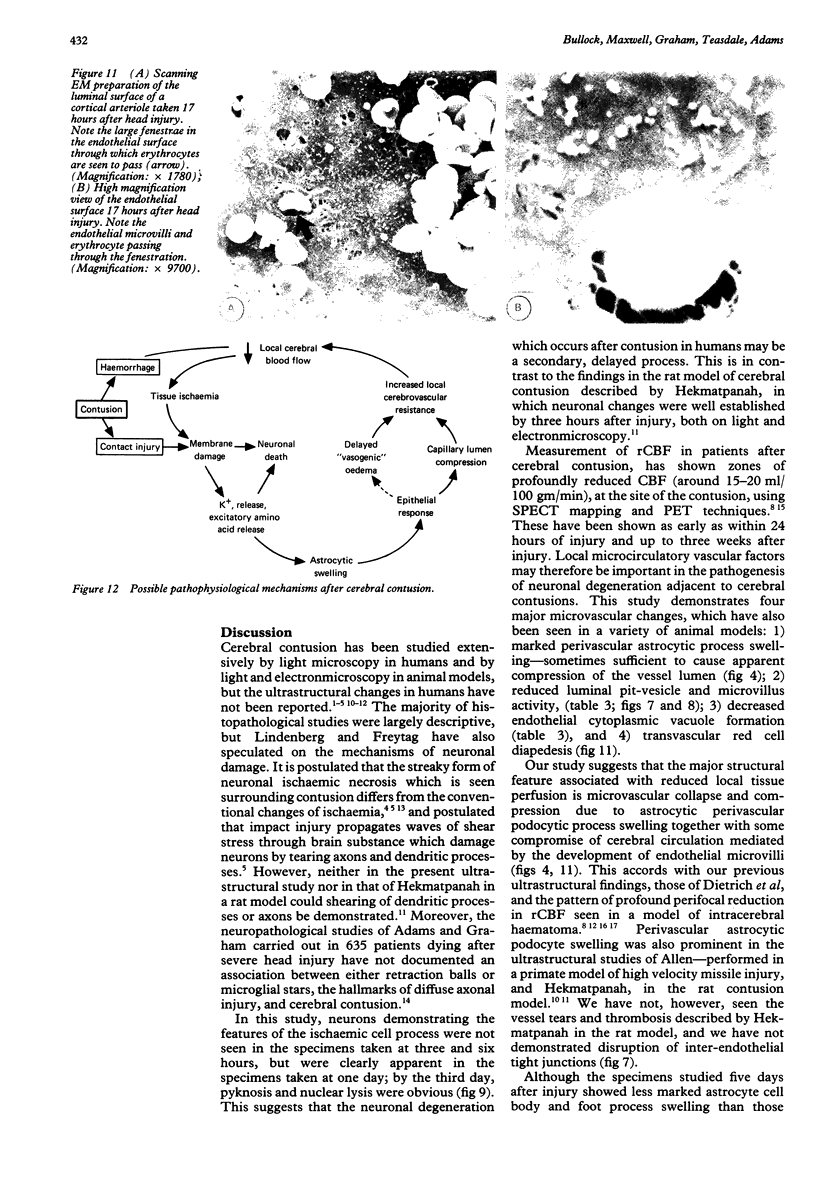
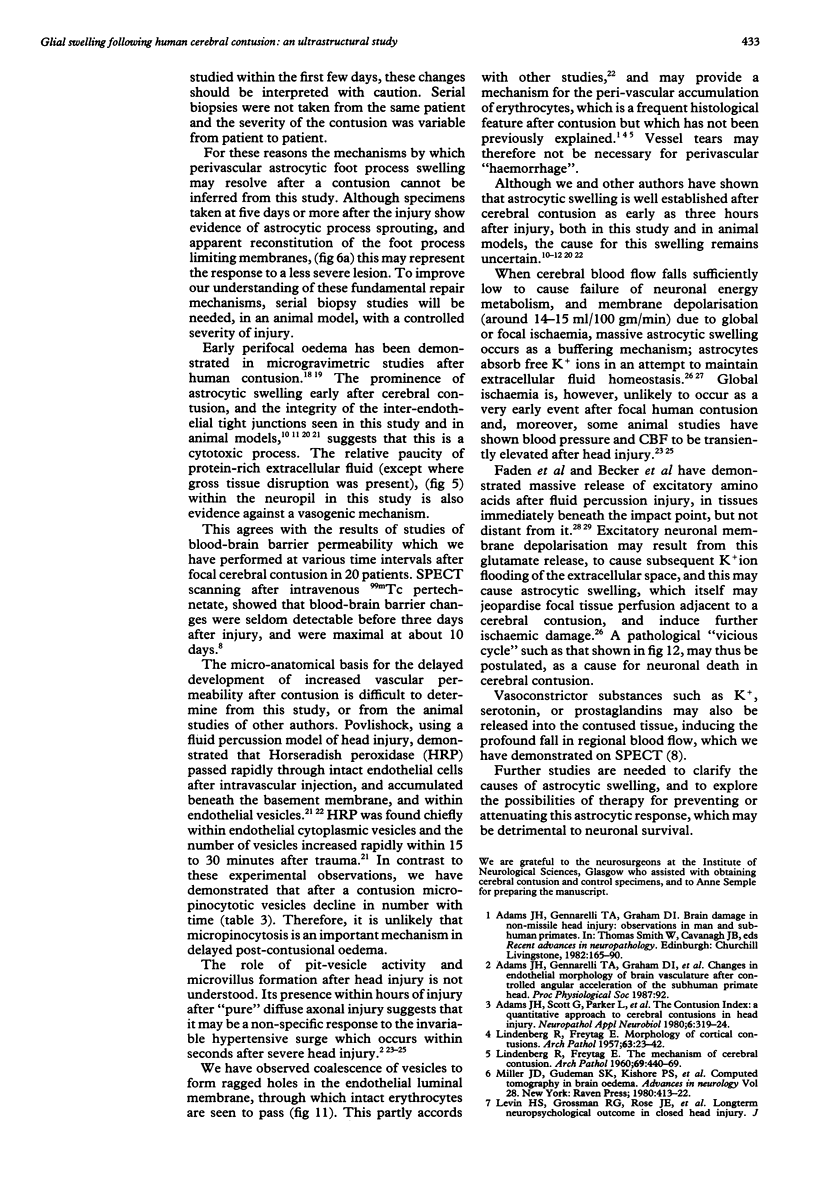
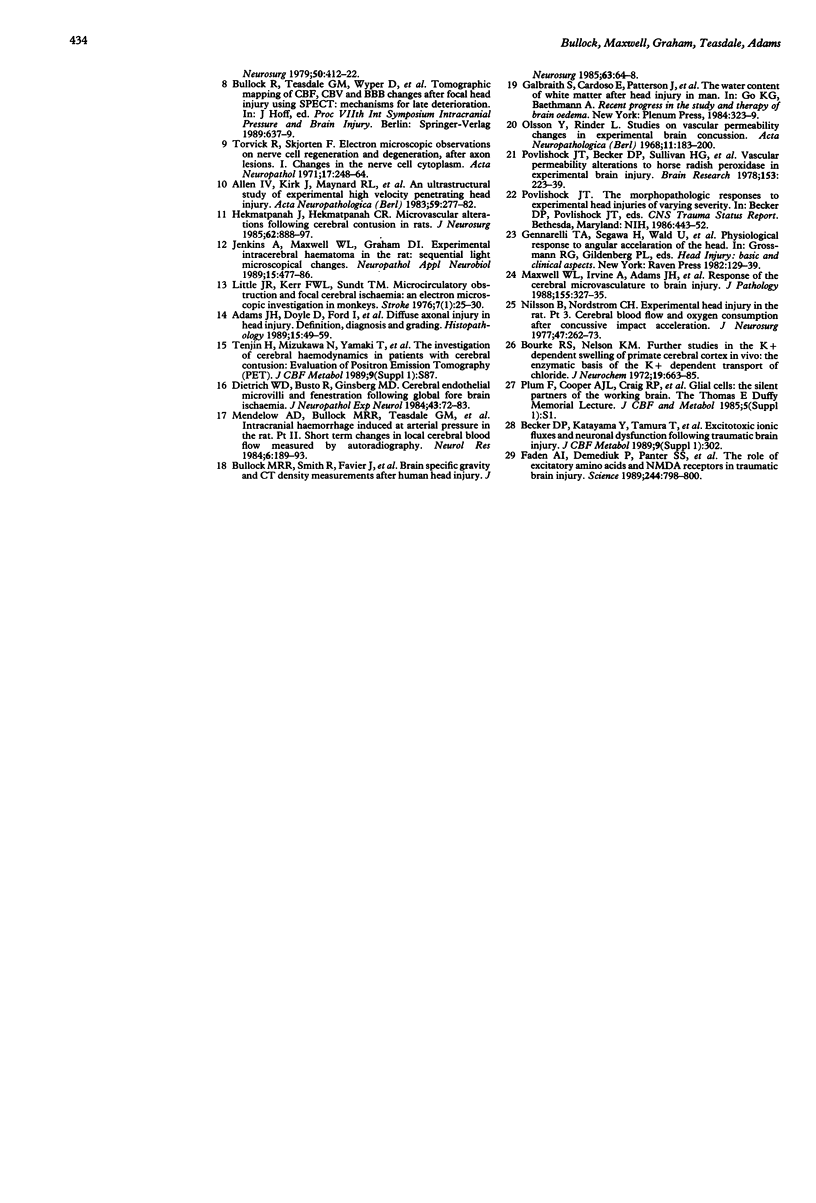
Images in this article
Selected References
These references are in PubMed. This may not be the complete list of references from this article.
- Adams J. H., Doyle D., Ford I., Gennarelli T. A., Graham D. I., McLellan D. R. Diffuse axonal injury in head injury: definition, diagnosis and grading. Histopathology. 1989 Jul;15(1):49–59. doi: 10.1111/j.1365-2559.1989.tb03040.x. [DOI] [PubMed] [Google Scholar]
- Adams J. H., Scott G., Parker L. S., Graham D. I., Doyle D. The contusion index: a quantitative approach to cerebral contusions in head injury. Neuropathol Appl Neurobiol. 1980 Jul-Aug;6(4):319–324. doi: 10.1111/j.1365-2990.1980.tb00217.x. [DOI] [PubMed] [Google Scholar]
- Allen I. V., Kirk J., Maynard R. L., Cooper G. K., Scott R., Crockard A. An ultrastructural study of experimental high velocity penetrating head injury. Acta Neuropathol. 1983;59(4):277–282. doi: 10.1007/BF00691493. [DOI] [PubMed] [Google Scholar]
- Bourke R. S., Nelson K. M. Further studies on the K + -dependent swelling of primate cerebral cortex in vivo: the enzymatic basis of the K + -dependent transport of chloride. J Neurochem. 1972 Mar;19(3):663–685. doi: 10.1111/j.1471-4159.1972.tb01383.x. [DOI] [PubMed] [Google Scholar]
- Bullock R., Smith R., Favier J., du Trevou M., Blake G. Brain specific gravity and CT scan density measurements after human head injury. J Neurosurg. 1985 Jul;63(1):64–68. doi: 10.3171/jns.1985.63.1.0064. [DOI] [PubMed] [Google Scholar]
- Dietrich W. D., Busto R., Ginsberg M. D. Cerebral endothelial microvilli: formation following global forebrain ischemia. J Neuropathol Exp Neurol. 1984 Jan;43(1):72–83. doi: 10.1097/00005072-198401000-00006. [DOI] [PubMed] [Google Scholar]
- FREYTAG E., LINDENBERG R. Morphology of cortical contusions. AMA Arch Pathol. 1957 Jan;63(1):23–42. [PubMed] [Google Scholar]
- Faden A. I., Demediuk P., Panter S. S., Vink R. The role of excitatory amino acids and NMDA receptors in traumatic brain injury. Science. 1989 May 19;244(4906):798–800. doi: 10.1126/science.2567056. [DOI] [PubMed] [Google Scholar]
- Hekmatpanah J., Hekmatpanah C. R. Microvascular alterations following cerebral contusion in rats. Light, scanning, and electron microscope study. J Neurosurg. 1985 Jun;62(6):888–897. doi: 10.3171/jns.1985.62.6.0888. [DOI] [PubMed] [Google Scholar]
- Jenkins A., Maxwell W. L., Graham D. I. Experimental intracerebral haematoma in the rat: sequential light microscopical changes. Neuropathol Appl Neurobiol. 1989 Sep-Oct;15(5):477–486. doi: 10.1111/j.1365-2990.1989.tb01247.x. [DOI] [PubMed] [Google Scholar]
- LINDENBERG R., FREYTAG E. The mechanism of cerebral contusions. A pathologic-anatomic study. Arch Pathol. 1960 Apr;69:440–469. [PubMed] [Google Scholar]
- Maxwell W. L., Irvine A., Adams J. H., Graham D. I., Gennarelli T. A. Response of cerebral microvasculature to brain injury. J Pathol. 1988 Aug;155(4):327–335. doi: 10.1002/path.1711550408. [DOI] [PubMed] [Google Scholar]
- Mendelow A. D., Bullock R., Teasdale G. M., Graham D. I., McCulloch J. Intracranial haemorrhage induced at arterial pressure in the rat. Part 2: Short term changes in local cerebral blood flow measured by autoradiography. Neurol Res. 1984 Dec;6(4):189–193. doi: 10.1080/01616412.1984.11739688. [DOI] [PubMed] [Google Scholar]
- Miller J. D., Gudeman S. K., Kishore P. S., Becker D. P. Computed tomography in brain edema due to trauma. Adv Neurol. 1980;28:413–422. [PubMed] [Google Scholar]
- Nilsson B., Nordström C. H. Experimental head injury in the rat. Part 3: Cerebral blood flow and oxygen consumption after concussive impact acceleration. J Neurosurg. 1977 Aug;47(2):262–273. doi: 10.3171/jns.1977.47.2.0262. [DOI] [PubMed] [Google Scholar]
- Povlishock J. T., Becker D. P., Sullivan H. G., Miller J. D. Vascular permeability alterations to horseradish peroxidase in experimental brain injury. Brain Res. 1978 Sep 22;153(2):223–239. doi: 10.1016/0006-8993(78)90404-3. [DOI] [PubMed] [Google Scholar]
- Rinder L., Olsson Y. Studies on vascular permeability changes in experimental brain concussion. I. Distribution of circulating fluorescent indicators in brain and cervical cord after sudden mechanical loading of the brain. Acta Neuropathol. 1968 Sep 25;11(3):183–200. doi: 10.1007/BF00692305. [DOI] [PubMed] [Google Scholar]
- Torvik A., Skjörten F. Electron microscopic observations on nerve cell regeneration and degeneration after axon lesions. I. Changes in the nerve cell cytoplasm. Acta Neuropathol. 1971;17(3):248–264. doi: 10.1007/BF00685058. [DOI] [PubMed] [Google Scholar]













